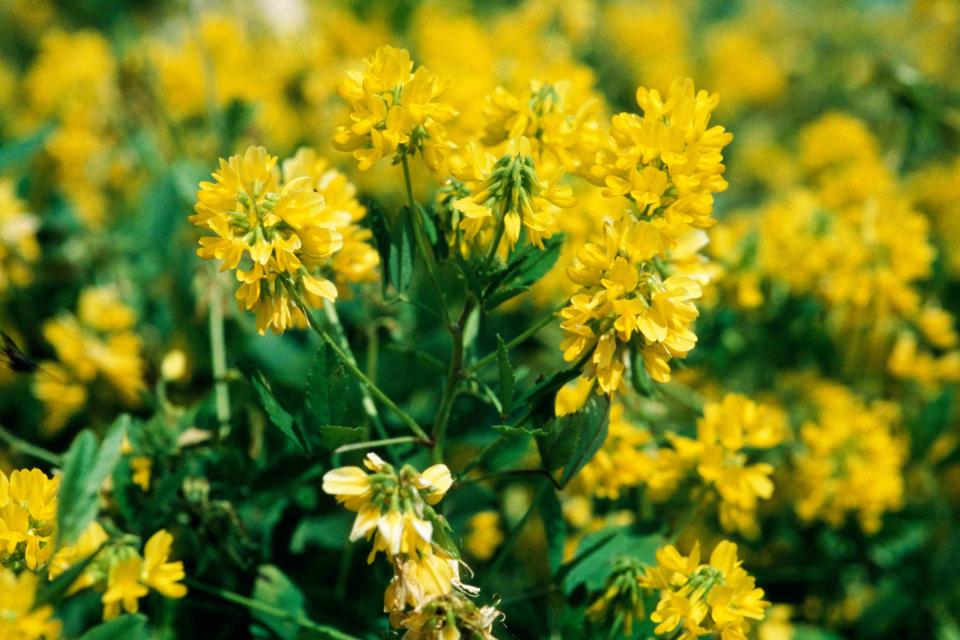How to Plant, Grow, and Care for Fenugreek
Add this annual herb to your garden for its tasty leaves and seeds.

DEA / E. BANFI / Getty Images
Long grown as a food source, spice, and medicinal herb, fenugreek is a relative of peanuts, beans, and other members of the legume family. Fenugreek is native to dry regions around the Mediterranean. Today, it's especially popular in India and is a major food ingredient in the region. In the U.S. this annual herb isn't common to gardens, but it deserves to be more widely grown for its tasty leaves and seeds, plus its pretty flowers.
Where to Plant Fenugreek
Fenugreek prefers full sun to part shade, and well-draining soil for best growth and flower production. Like other legumes, fenugreek is a good candidate for crop rotation and will improve depleted garden soils. After the growing season has ended, till plants into the soil where they will continue adding nutrients as they break down.
How and When to Plant Fenugreek
Fenugreek does not transplant well. Because of this, sow seeds directly into the garden after the risk of frost has passed in spring, and the soil has warmed. Plant seeds about 1/4 inch deep and water well. Seedlings are quick to grow and should begin emerging within the first week after planting.
Care Tips for Fenugreek
Light
Fenugreek prefers full sun, but can tolerate some shading in hotter climates. For the best flower and pod production, give plants the most sunlight you can.
Soil and Water
Other than needing good drainage, fenugreek is not as picky as non-legumes about soil. Like its relatives, fenugreek can fix (add) nitrogen to the soil. In other words, degraded or otherwise, low-nutrient soils can be improved by growing fenugreek and tilling in the plants at the end of each growing season.
Although plants should be watered regularly, too much water can lead to root rot and total dieback in plants.
Temperature and Humidity
As natives of arid regions, these plants do best when grown in warm to hot and dry conditions. In cooler areas, planting up against the south side of a fence or other structure can help to increase ambient temperatures.
Fertilizer
Fertilizer is not necessary for all but seriously depleted soils. However, enriching the soil with compost or aged manure can help increase productivity and improve the soil for future plantings as well.
Pruning
While pruning is not necessary, it may be helpful to pinch off the central growth points to encourage fuller, bushier plants. However, pruning should only be done early on or otherwise risk removing flowers.
:
Pests and Problems
Fenugreek is rarely bothered by disease. Insect pests such as aphids are somewhat common, but will not typically kill plants and can be treated with a variety of organic pesticides such as insecticidal soap.
In water-logged soils, root rot is common and will destroy crops if soils are not amended prior to planting. The addition of sand and compost can help to improve soil drainage. Likewise, in areas with high humidity, powdery mildew can become bothersome and should be treated with an organic fungicide like neem oil or copper sprays.
How to Propagate Fenugreek
As an annual plant, propagation is done primarily through seeds. After pods have dried, harvest the seeds and store them in a cool, dark location until ready for sowing. Before planting the seeds, soak them overnight in a dish of water.
Frequently Asked Questions
Is fenugreek poisonous?
<p>While fenugreek is not poisonous in normal amounts, it should not be consumed by pregnant people and can cause allergic reactions in those with a sensitivity to legumes, particularly for someone with a known peanut allergy. </p>
When can leaves be harvested?
<p>Fenugreek seeds, seedlings, and leaves are all edible. However, leaves are best used prior to flowering. As the plant blooms, the leaves become tough and less palatable.</p>
Can fenugreek be grown in pots?
<p>Yes! Fenugreek plants are easy to grow in pots because of their shallow root systems. Provided with good lighting, plants can also be grown indoors, <a href="https://www.bhg.com/how-to-grow-sprouts-6824808" data-component="link" data-source="inlineLink" data-type="internalLink" data-ordinal="1">especially as sprouts</a> and microgreens.</p>

